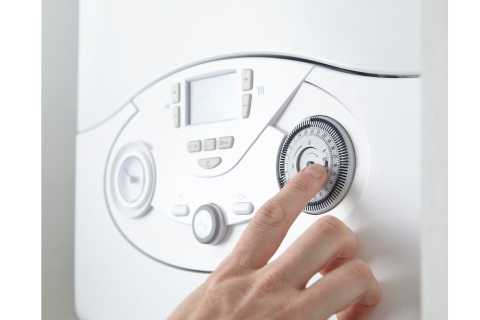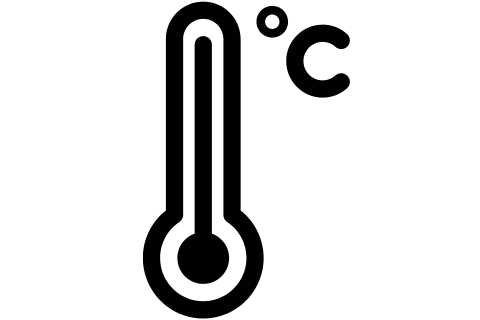Ever turned on your heating system and wondered how it maintains a consistent temperature? Well, it all comes down to one key factor: boiler flow temperature.
It’s like a maestro orchestrating the right balance of energy efficiency and warmth in your home. In this guide, our experts from Easy Boilers will take you through everything you need to know about boiler flow temperature and how to turn it down and up required.
Get new boiler quotes online >
Combi Boiler Flow Temperature Overview
- Why is it important? – Understanding boiler flow temperature is essential for optimal performance and energy efficiency.
- What hot water temperature is best? – The optimal boiler flow temperature settings range from 60°C to 75°C, with adjustments made using dials or buttons.
- How to do it – Regular maintenance, advanced features like weather compensation, insulation and smart meters can help improve comfort levels while reducing energy bills.
Understanding Boiler Flow Temperature
Boiler flow temperature is a bit like the beating heart of your central heating system. It’s what keeps your home warm and comfortable during those chilly winter nights. But what exactly is it?
Simply put, heating flow temperature refers to the temperature of the water that flows from the boiler to heat your home.
This aspect of your heating system requires careful regulation and balance for optimal performance and comfort. And it’s not just about keeping you warm – it’s also about energy efficiency.
Learning to reduce boiler flow temperature is also a way to decrease our heating bills, rendering our homes not only warmer but also more economical. Even the most efficient boilers will mean higher bills if your settings arent right.
Now, you might be wondering: How is the boiler flow temperature controlled? This is where the system boiler comes in. The system boiler acts as the regulator of your heating system, managing boiler flow temperature to maintain your rooms at the desired temperatures.
So, whether you’re curling up on the couch or hosting a dinner party, your boiler and heating system have got you covered!
Types of Boilers and Flow Temperature Control

Just like every home is unique, so is every boiler. There are different types of boilers, each with its own way of controlling temperature and distributing heat. There are three types of boilers: combi, heat-only, and system. Each type has its own unique advantages and disadvantages..
Combi boilers, also known as condensing boilers, are the all-in-one option. They provide both heating and hot water in a single unit, making them a popular choice for modern homes.
What makes them unique is their on-demand water heating capability, which results in a lower combi boiler flow temperature and hence, increased energy efficiency.
However, adjusting the hot water temperature on a combi boiler requires caution to prevent risks associated with Legionella and to ensure the room thermostat is set correctly.
On the other hand, heat-only boilers and system boilers, which are types of heating systems, typically do not provide the option to modify the radiator flow temperature independently from the hot water temperature.
These boilers require an additional storage tank, such as a hot water cylinder, to store hot water and provide heating by circulating warm water through radiators.
No matter the type of boiler, it’s important to regulate the boiler’s flow temperature for optimal efficiency and comfort in your house.
Optimal Combi Boiler Flow Temperature Settings
Having understood what combi boiler flow temperature is and its regulation, let’s discuss specific numbers related to boiler temperature. So, what are the optimal combi boiler flow temperature settings?
The optimal combi boiler flow temperature setting typically ranges from 60°C to 75°C for most systems. But why this range?
Well, the beauty of this temperature range is that it allows a balance between efficiency, reducing fuel consumption, and maintaining comfort levels.
Imagine it as the sweet spot where your combi boiler performs at its best, keeping your home warm and your energy bills in check.
However, it’s important to note that these are not set in stone. Depending on your heating system and personal preferences, these settings may vary.
Keep in mind, every home has its unique characteristics, and the combi boiler flow temperature is just one component contributing to its functionality.
Read more about the best combi boilers in our guide now for more info.
Adjusting Your Boiler’s Flow Temperature
But what if you’re feeling too warm or too cold? Can you change the boiler flow temperature? Absolutely. Depending on the boiler model, you can adjust the boiler’s flow temperature using dials, digital displays, or buttons.
Boilers with dials are quite straightforward. Just turn the dial to the desired setting. For initial setting, it’s suggested to set the dial to No.3 or the halfway mark (12 o’clock position).
For boilers with digital displays and buttons, you can simply press the up and down buttons to adjust the flow temperature. But before you start playing around with the settings, it’s always a good idea to consult your manufacturer’s manual for specific guidance.
Regulating your boiler’s flow temperature is not just about comfort; it also relates to boiler efficiency. Finding the right balance allows your boiler to operate at peak efficiency, cutting down your energy consumption and subsequently your gas bills.
It’s like fine-tuning an instrument – with the right settings, you can hit all the right notes!
Risks and Precautions When Lowering Flow Temperature

Although reducing your boiler flow temperature can enhance energy efficiency, it comes with its own risks.
Just like turning down the heat too low can make your home uncomfortably cold, lowering the boiler flow temperature too much can lead to issues such as Legionella growth and reduced heating efficiency.
To avoid these problems, it’s important to maintain lower flow temperatures that are still within a safe and efficient range.
Legionella is a type of bacteria that can thrive in water systems, including boilers.
When the boiler flow temperature is set too low, it can provide the ideal conditions for these bacteria to multiply, posing a health risk. That’s why it’s important to maintain a minimum return temperature of 55°C.
But don’t worry, with a bit of care and attention, these risks can be easily managed. Understanding potential risks and taking appropriate precautions allow you to safely reduce your boiler flow temperature and reap the benefits of a more energy-efficient home.
Advanced Features for Better Efficiency and Comfort
The function of boilers is not limited to temperature settings. There are also advanced features that can enhance the efficiency and comfort of your heating system.
Features such as weather compensation, larger radiators, and energy-efficient circulator pumps can make a big difference in how your boiler performs.
Consider weather compensation as a weather predictor for your boiler. It adjusts the boiler’s flow temperature in response to external weather conditions, ensuring your home stays warm on cold days and cool on warm days.
It’s like having a personal assistant that adjusts your home’s heating based on the weather outside.
These advanced features aren’t just about making your home more comfortable; they’re also about saving energy. Improving the efficiency of your heating system with these features can lower your energy bills and carbon footprint. It’s a win-win situation!
Regular Maintenance and Servicing
Similar to how a car needs routine servicing for smooth operation, your boiler also necessitates regular maintenance for ideal flow temperature. Regular check-ups can extend the lifespan of your boiler, minimize repair costs, and ensure safety.
Cleaning the heat exchanger surfaces, inspecting seals and gaskets for any wear or damage, are essential maintenance tasks. Additionally, verifying the functionality of safety devices like the pressure relief valve and low water cut-off switch is also important..
It’s recommended to have your boiler serviced at least once a year. Routine service checks aid in identifying possible issues such as gas leaks or carbon monoxide emissions, and enhance efficiency by cleaning and fine-tuning the boiler components.
So, just like going for a regular health check-up, make sure to schedule regular maintenance for your boiler too!
Additional Energy-Saving Tips
Apart from managing boiler flow temperature and incorporating advanced features, other methods can also contribute to energy saving and increasing home efficiency. Consider proper insulation, using smart meters, and taking personalised energy-saving advice.
Appropriate insulation can help maintain warmth in the winter and coolness in the summer, thereby reducing the reliance on heating and air conditioning. It’s like wrapping your home in a cozy blanket to keep the warmth in and the cold out.
Smart meters can help you monitor your energy consumption, letting you see where you can save. And personalized energy-saving advice can provide you with tailored tips based on your specific needs and circumstances. Every little helps, and together, these measures can add up to significant energy savings.
Identifying Issues and When to Call a Professional
Similar to how a musician recognizes when their instrument is not in tune, you should also be aware of any irregularities with your boiler. Irregular pressure fluctuations, inconsistent heating, and unusual noises are all signs that something might be wrong when your boiler heats.
Pressure fluctuations can directly affect your boiler flow temperature, with higher pressure leading to an increase in temperature and lower pressure resulting in a decrease.
To ensure consistent and optimal flow temperatures, it is important to maintain stable pressure in the boiler system.
If you notice any of these signs, it’s time to call a professional:
- Strange noises coming from the boiler
- Leaking or dripping water
- Weak or no heat
- Frequent pilot light outages
- Unusual smells, such as a rotten egg odor
- High energy bills
- Carbon monoxide detector going off
Routine maintenance and servicing can aid in early detection of issues and guarantee the safe and efficient operation of your boiler. Recognizing when it’s time to call in the professionals is key in maintaining your boiler at its best performance.
Summary
We’ve journeyed through the world of boilers, understanding the importance of boiler flow temperature, learning about different types of boilers, and exploring how to adjust temperature settings for optimal comfort and efficiency.
We’ve also delved into the risks and precautions when lowering flow temperature, examined some advanced boiler features, and shared some extra energy-saving tips.
By understanding and managing our boiler flow temperature, we can create a more comfortable and energy-efficient home. So, let’s turn up the heat on our boiler knowledge and enjoy a warm and cozy home!
Frequently Asked Questions
What flow temperature should my boiler be?
For optimal efficiency, set your boiler’s flow temperature to 60°C in most households. If you have a well-insulated modern home, aim for 50°C instead.
What is the boiler setting 1 to 6?
The boiler setting 1 to 6 ranges from a cool room temperature to a cosy one with 3 being the middle ground.
How can I adjust my boiler’s flow temperature?
To adjust your boiler’s flow temperature, use the dials, digital displays, or buttons on the boiler, following the manufacturer’s instructions.
What advanced features can increase my boiler’s efficiency and comfort?
Advanced features such as weather compensation, larger radiators, and energy-efficient circulator pumps can increase your boiler’s efficiency and comfort, providing you with an improved home heating experience.
When should I call a professional for boiler maintenance and servicing?
It is recommended to contact a professional for boiler maintenance and servicing at least once a year to ensure optimal performance.